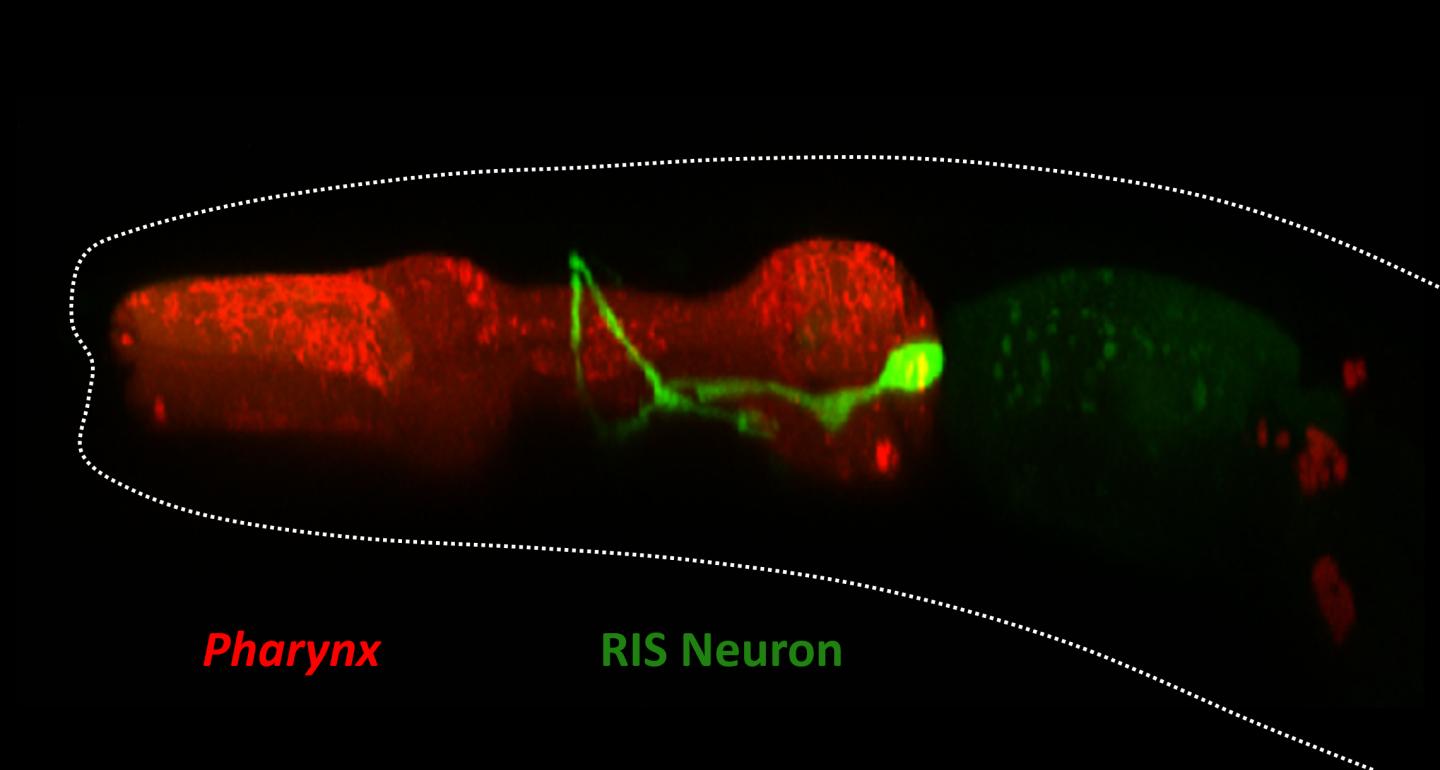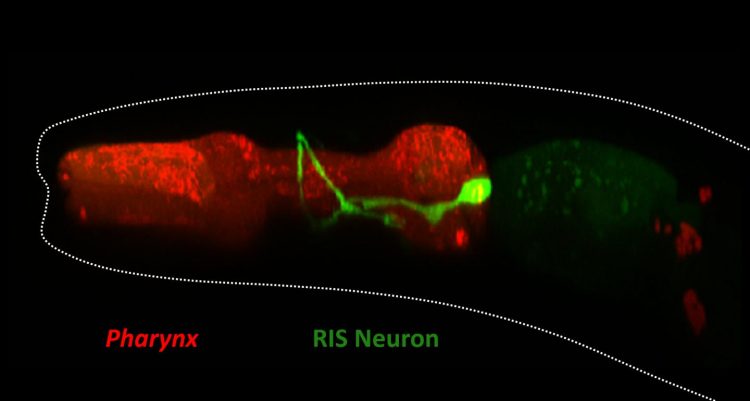Sleep or stop? The RIS neuron has both functions; publication in Nature Communications

Credit: Wagner Steuer Costa
Wagner Steuer Costa in the team of Alexander Gottschalk, Professor for Molecular Cell Biology and Neurobiochemistry, discovered the sleep neuron RIS a few years ago by coincidence – simultaneously with other groups. To understand the function of individual neurons in the plexus, the researchers use genetic engineering to cause them to produce light-sensitive proteins. With these “photo-switches”, the neurons can be activated or turned off in the transparent worm using light radiation of a certain wavelength. “When we saw that the worm froze when this neuron was stimulated by light, we were quite amazed. It was the beginning of a study that took several years,” Gottschalk recalls.
The RIS neuron puts C. elegans to sleep when it is active for minutes or hours – for example after the shedding of the cuticle (a secreted form of skin) that is a process in the animal’s development. It also sleeps in order to recover after experiencing cellular stress. On the other hand, the neuron serves to stop the worm during locomotion – for example, if it wants to change direction or to avoid danger. The neuron then slows down the animal’s motion so that it has time to decide if it wants to continue crawling. In this case the neuron is only active for a few seconds. “Such stop neurons have only recently been discovered. This is the first one of its kind in a worm,” explains Gottschalk.
Interestingly, the axon of the RIS neuron is apparently branched, with the two branches having different functions, so that RIS not only slows motions but can also introduce backwards motion. This is reported by Gottschalk and his collaboration partners, Professor Ernst Stelzer from Goethe University, Professor Sabine Fischer from the University of Würzburg, researchers from the American Vanderbilt University in Nashville and KU Leuven in the current issue of Nature Communications.
“We think that neurons with a double function exist in numerous simple life forms such as the worm. In the course of evolution they were then assigned to two different systems in the brain and further developed,” says Gottschalk. It’s a theme that will certainly be found to recur once other nerve cells of the worm are better understood. “The nervous system of C. elegans can be viewed as a kind of evolutionary test bed. If it works there, it will be used again and further refined in more complex animals.”
The discovery of the double function of RIS is also an example of how a permanently connected neuronal network can be additionally operated by a “wireless” network of neuropeptides and neuromodulators. This enables several functional networks to be realised on a single anatomical network, enormously increasing the functionality of the worm’s brain, as well as being very economical. “It should no longer be said that worm neurons are simple. Often, they can do more than mammalian neurons,” says Gottschalk.
###
Publication: Wagner Steuer Costa, Petrus Van der Auwera, Caspar Glock, Jana F. Liewald, Maximilian Bach, Christina Schüler, Sebastian Wabnig, Alexandra Oranth, Florentin Masurat, Henrik Bringmann, Liliane Schoofs, Ernst H.K. Stelzer, Sabine C. Fischer, Alexander Gottschalk: A GABAergic and peptidergic sleep neuron as a
locomotion stop neuron with compartmentalized Ca2+ dynamics https:/
Images may be downloaded at: http://www.
Caption: The threadworm C. elegans. Credit: A. Gottschalk
Caption: The RIS neuron (green) in the throat of the threadworm C. elegans. Credit: Wagner Steuer Costa
Interesting videos can also be viewed on the Nature Communications website, e.g.. #7:
https:/
Further information: Prof. Dr. Alexander Gottschalk, Molecular Cell Biology and Neurobiology and Institute for Biophysical Chemistry, Faculty of Biochemistry, Chemistry and Pharmacy, and Buchmann Institute for Molecular Life Sciences, Riedberg Campus, Tel.: +49 069 798-42518 , Email: [email protected].
Current news about science, teaching, and society can be found on GOETHE-UNI online (http://www.
the University is a research-oriented university in the European financial centre Frankfurt am Main. The university was founded in 1914 through private funding, primarily from Jewish sponsors, and has since produced pioneering achievements in the areas of social sciences, sociology and economics, medicine, quantum physics, brain research, and labour law. It gained a unique level of autonomy on 1 January 2008 by returning to its historic roots as a “foundation university”. Today, it is one of the three largest universities in Germany. Together with the Technical University of Darmstadt and the University of Mainz, it is a partner in the inter-state strategic Rhine-Main University Alliance. Internet: http://www.
Publisher: The President of Goethe University Editor: Dr. Anne Hardy, Science Editor, PR & Communication Department, Theodor-W.-Adorno-Platz 1, 60323 Frankfurt am Main, Tel: -49 (0) 69 798-13035, Fax: +49 (0) 69 798-763 12531, [email protected].
Media Contact
Alexander Gottschalk
[email protected]
Original Source
https:/
Related Journal Article
http://dx.





